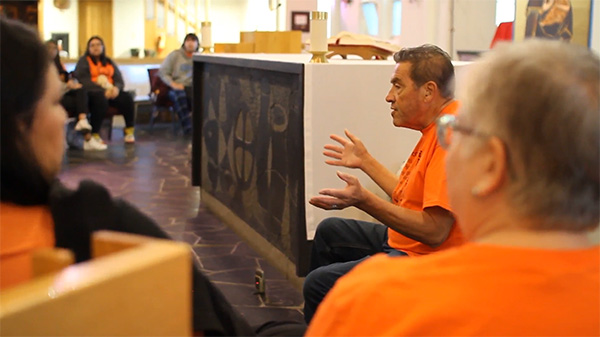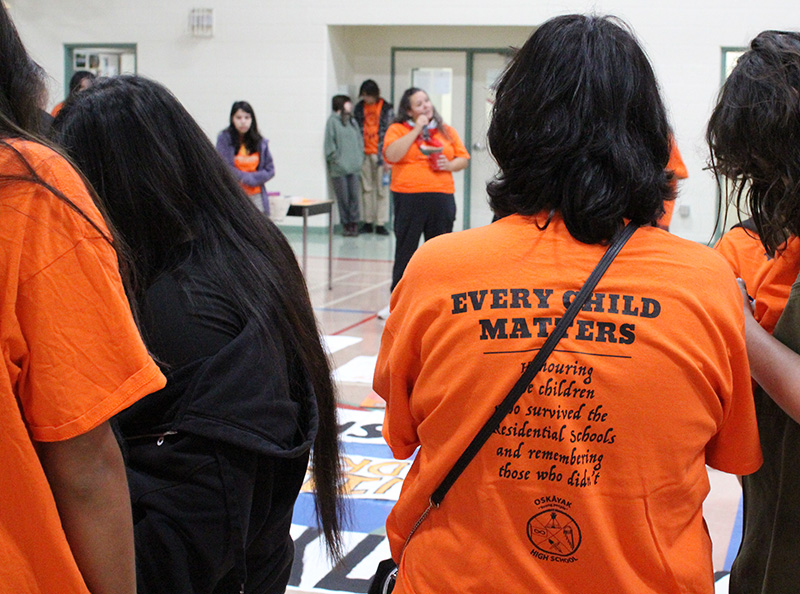
Teepee integral to STM College's journey toward reconciliation
STM Scholar in Indigenous Education Harry Lafond hosts talks in STM Chapel where sacred traditions come together in healing
By Paul Sinkewicz“This is a sacred place,” said Harry Lafond to a diverse group that gathered recently in the very heart of St. Thomas More College – its chapel.
He spoke about how there is a solemnity to being there, as it is a place of prayer and connection to the spiritual.
“It is a place for people to gather using the Catholic ceremonies and to get that spirituality happening in this College. And so, it’s a sacred place. In our world, in the Cree world, the sacred place has been recognized as being inside a teepee. It represents that same purpose that we have in a building like this.”
On Sept. 24, as part of the College’s work toward reconciliation, and leading up to the National Day for Truth and Reconciliation, STM held an event titled Together on a Journey Toward Reconciliation: A Teepee, A Chapel and the Hope for a Better Future.
Campus Minister Michael MacLean welcomed faculty, staff and other USask faith leaders, as well as the students in attendance, including USask Peer Health Mentors and STM Peer Health Mentors.
The teepee was installed in the STM chapel in March of 2022 with the encouragement of the STM Indigenous Advisory Circle, and after a long process of discernment. The College committed to respectfully using the space, and to ongoing education about sacred teepee teachings.
Lafond is the STM Scholar in Indigenous Education and a Deacon with the Diocese of Prince Albert. He is also the former chief of the Muskeg Lake Cree Nation, where he grew up and still lives.
He spoke about how a teepee as portrayed in Hollywood was a kind of one-dimensional shorthand to indicate the presence of ‘Indians’, as Indigenous people were commonly known throughout North American history.
But to really understand the significance of a teepee, and to honour the culture it represents, there is much to unpack, he said.
“The Truth and Reconciliation Commission of Canada Calls to Action give us certain actions that we should bring into our lives to ensure that we break the historical line of colonization in Canada, in Saskatoon, our small towns and our farming communities” Lafond said.
“And so, the conversation became ‘How do we bring sacred spaces together that demonstrates that we’re moving in a direction of trying to understand each other?’”
Lafond pointed out that the Kurelek mural gracing the north wall of the chapel depicts a prairie scene with a conspicuous absence of adequate Indigenous representation in the crowd.
“There is the odd feather in there,” he said. “But if we’re going to bring this image into today’s reality, we have to balance out the story. And the story is not accurate. This image is not accurate according to our standards today. It might have been okay when the artist was putting it up there, that was the thinking of the time and we’re not pointing fingers here, we’re just saying stories change, relationships change, and so we should try as much as possible to make sure the imagery evolves as well.”
Lafond said erecting the teepee on the left side of the mural seemed like a natural fit.
“What we hope it does is bring us to today’s world. Now you look at that scene and you say ‘Oh yeah. There are Indigenous people.’
“We say we are on Treaty 6 land, but it’s more than that. There are people who spent the last 400 years disappearing, and that’s why there are only two or three Indigenous people blended in to all those people in the mural.”
“So, the teepee is there. It’s an expression of St. Thomas More’s desire to understand how Indigenous spirituality and Catholic spirituality have a lot to explore. They have a lot to look at, to talk about, to experiment, to push the limits of who we are as human beings.”
In his own family’s history, Lafond said 150 years ago his great grandparents used the teepee as their home. Later, families began to build cabins.
The teepee was a home, but then it was no longer used as a home for many years, he said, and he grew up with little knowledge of the teepee. But thankfully that changed later in life, thanks to elders like Mary Lee, who shared their knowledge.
In 1972, the Saskatchewan Indian Cultural Centre (originally the Saskatchewan Indian Cultural College), was mandated to promote the preservation of Indian culture through the production of a curriculum as well as other activities. It started talking with elders about how to pass along knowledge to children and grandchildren, and they started to think about the teepee.
A curriculum was created centered on the teepee to teach Indigenous culture and traditions. Central to the curriculum, like the three poles that form the foundation of a teepee, were the three pillars of obedience, respect, humility.
Those ideas can be encompassed in Wahkotowin – Cree word which means kinship and denotes the interconnected nature of relationships, communities, and natural systems.
“Humility is really important, then, because in order for us to establish a relationship, we have to allow other people to come into our life,” Lafond said. “We have to allow them to come in and we have to engage with them to have them accept us into their life.”
“So, when we talk about reconciliation, it’s a good place to begin. It’s a good place to learn from.”
He said the teepee teaches us we have to respect each other’s definition of reconciliation and how it needs to proceed.
“It has become a sacred place for Indigenous people. There is nothing big that happens without a pipe ceremony in a teepee leading up to the event.”
That ceremony is a prayer and a chance to give thanks to the Creator.
“So, the teepee is a good place, and if you ever feel the need for absolute quiet, go in there and just sit. There’s nothing more powerful than absolute quiet to bring peace to your soul. It’s a prayerful place.”
Lafond was again in the heart of STM College on Friday, Sept. 27, when students and teachers from Oskayak High School visited the STM Chapel to listen to his talk about reconciliation and the teepee’s meaning.
He invited the students to get to know St. Thomas More College, and the University of Saskatchewan, as a possible destination for their future learning.
“This College has been working really hard for the past 10 years to try to understand how Indigenous people fit into society and particularly this College. This is not an exclusive, but rather an inclusive, place to be. We’ve incorporated a lot of Indigenous practices in here, always under the guidance of elders. That’s what we do here, to make sure we are honouring the Indigenous knowledge that is gifted to us through different people.”
Later in the day, staff and faculty from St. Thomas More College joined the Oskayak school community for their Orange Shirt Day Walk. The group walked through the Broadway area and across two bridges before returning to the school, capping a great day of strengthening bonds of friendship to mark the National Day for Truth and Reconciliation.










